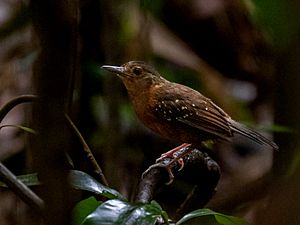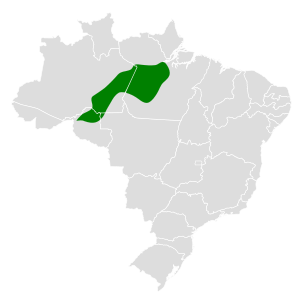Rufous-faced antbird facts for kids
Quick facts for kids Rufous-faced antbird |
|
|---|---|
 |
|
| male | |
 |
|
| female | |
| Conservation status | |
| Scientific classification | |
| Genus: |
Myrmelastes
|
| Species: |
rufifacies
|
 |
|
| Synonyms | |
|
|
The rufous-faced antbird (Myrmelastes rufifacies) is a type of bird that belongs to the Thamnophilidae family. These birds live in the wet, humid forests of the Brazilian Amazon. You can find them south of the Amazon River and east of the Madeira River.
Contents
About the Rufous-faced Antbird
The rufous-faced antbird is a small bird known for its unique appearance. It lives in the dense parts of the Amazon rainforest. This bird is part of a group called antbirds, which are known for following army ants to catch insects that the ants stir up.
Where They Live
Rufous-faced antbirds prefer humid forests. Their home is in a specific part of the Amazon. This area is in Brazil, south of the mighty Amazon River. It is also found east of the Madeira River. This special location helps define their natural habitat.
How We Know This Bird
For a long time, the rufous-faced antbird was thought to be a subspecies of another bird. It was considered a type of spot-winged antbird. A subspecies is like a different version of a species. It has small differences but is still very similar.
Becoming Its Own Species
In 2007, scientists studied the sounds these birds make. They listened carefully to their calls and songs. They found that the rufous-faced antbird's sounds were very different. These differences were big enough to make it its own separate species.
Today, the rufous-faced antbird is known as "monotypic." This means it is the only type of bird in its species. There are no other subspecies of the rufous-faced antbird.
Looking After the Rufous-faced Antbird
The health of animal populations is very important. Experts check how many birds are left in the wild. This helps them decide if a species needs protection.
Conservation Status
BirdLife International is a group that studies birds around the world. They have looked at the rufous-faced antbird. They decided its conservation status is "Least Concern." This means that the bird is not currently in danger. There are enough of them in the wild. This is good news for the rufous-faced antbird!
See also
 In Spanish: Hormiguero del Tapajós para niños
In Spanish: Hormiguero del Tapajós para niños


